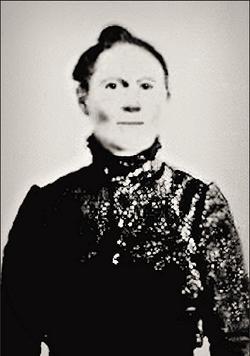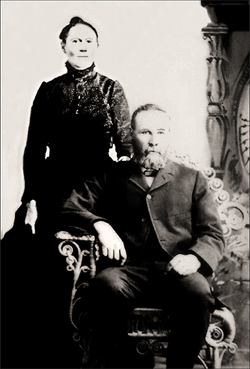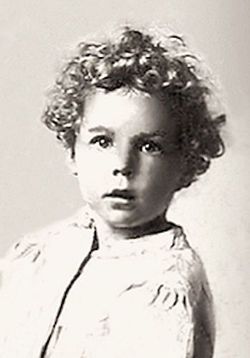| Description |
: |
Our sincere appreciation to R. JOHNSON for being so generous to take her time to go to the Moravia Cemetery to take photos of Elizabeth GILMORE's headstone. THANK YOU, our family is truly grateful.
--------------------------------------------------------
Elizabeth Mary McCASKEY was born in Ireland ca 1829 and was an Irish immigrant to the United States of America; the date of her arrival in America is uncertain. At the age of twenty, on November 14, 1849 in Philadelphia, Pennsylvania, she and James GILMORE, né GILMOUR Jr., age twenty-one and formerly of County Tyrone, Ireland, were married; they made their home in Saint...
Read More
|
Our sincere appreciation to R. JOHNSON for being so generous to take her time to go to the Moravia Cemetery to take photos of Elizabeth GILMORE's headstone. THANK YOU, our family is truly grateful.
--------------------------------------------------------
Elizabeth Mary McCASKEY was born in Ireland ca 1829 and was an Irish immigrant to the United States of America; the date of her arrival in America is uncertain. At the age of twenty, on November 14, 1849 in Philadelphia, Pennsylvania, she and James GILMORE, né GILMOUR Jr., age twenty-one and formerly of County Tyrone, Ireland, were married; they made their home in Saint Georges Hundred, New Castle County, Delaware.
The 1850 Federal Census for Saint Georges Hundred in New Castle County listed the James GILMORE family under the name of James GILMER instead of GILMORE or GILMOUR [it was not unusual for census errors to occur in the older censuses, especially spelling errors (most people during these times had limited education opportunities which resulted in incorrect spellings plus the various languages and accents of the immigrants contributed to misunderstandings of what the family names were)]. The June 1st, 1850 census information for the GILMER family was enumerated on July 31st, 1850 and shows James, age 22, employed as a "laborer." He and [wife] Elizabeth, age 21, were residing in Dwelling 279 as Family 285. [James' mother], Martha age 45, and [his three youngest siblings]: Iabella [sic; Isabella] age 7; Jane age 5 [a.k.a. Frances Jane and as "Fannie" or "Fanny"]; and Thomas age 3 were living with the couple. The birth place of each household member was Ireland, each were shown with the misspelled surname of GILMER, none of the children had attended school within the year, and the relationships between the individuals were not indicated but can be surmised by their names and ages and the sequence in which they are listed.
The family listed on the 1850 Census prior to the GILMER family is shown as residents in Dwelling 278 and are identified as Family 284; the Head-of-Household was John ALSTON, place of birth: Maryland, age 50. He was a farmer and owned land valued at $12,000 [an amount of this value for this era indicated Mr. ALSTON was a middling or an average size landowner in regard to his acreage and wealth]. Jesse, age 22, and Ann, age 19, lived in Mr. ALSTON's home; the couple's surname was misspelled as MINKINS, the correct name is MEEKINS. The census showed that Jesse and Ann had been married within the year; Jesse was a farmer who had been born in Maryland and Ann's place of birth had been Ireland. The Delaware Marriage Records indicated Jesse MEEKINGS [sic] and Ann GILMORE, residents of New Castle County, Delaware, were married on June 22, 1850.
Mrs. Ann MEEKINS, the former Miss Ann GILMORE a.k.a. GILMOUR, was the sister that immigrated with James GILMORE, né GILMOUR Jr. to America in 1847. They both worked for John ALSTON to earn money to send home to Ireland to help their mother and siblings with living expenses and savings for fare to America to join James and Ann. From the census and from other information that is known about James and Ann GILMORE and Mr. ALSTON, it is believed that Ann was employed by Mr. ALSTON as a live-in housekeeper. Since she and her husband Jesse were recorded on the census as living in Mr. ALSTON's household, they must have had quarters within the house (possibly in the attic or in a part of the kitchen wing) to make it more convenient for Ann to be readily available for household duties.
The 1850 Census for this area in Delaware is structured to reflect the labor agreements commonly used during this era by landowners engaged in farming. This section of the census is based on listing the landowner household first followed by their tenant-laborers or tenant-farmers households; the landowner will have column eight filled in with a dollar value of the real estate they owned. The households following the landowner will not have column eight filled due to their status of being a tenant who leased from the landowner either as a tenant-laborer or tenant-farmer. Since James was listed as a laborer living with his family in their own household on Mr. ALSTON's farm, he would be classified as a tenant-laborer and not as a transient laborer.
John ALSTON (1794-1872/1874) was a Quaker farmer whose estate was between Middletown and Odessa in southern New Castle County, Delaware. In his lifetime he inherited a farm of 153 acres from his grandfather and father, and after a marriage in 1856, at the approximate age of 62, he also controlled the farm inherited by his wife. For the majority of his life, he managed his property by relying on live-in housekeepers for his home, and for his farm, he hired transient laborers as needed and had his tenant-laborers available throughout the annual seasons to cultivate a range of crops which included wheat, Indian corn, oats, Irish potatoes and hay. In addition to crops, the laborers cared for a small amount of livestock that was raised for milk and butter or slaughter. When it came to his fields being plowed, Mr. ALSTON placed more value on the speed of horses for plowing over using the more economical, versatile, and stronger oxen. (Siders and Andrzejewski, 1997, 162)
Based on the 1850 Census data, Mr. ALSTON owned at least two small tenement houses on his estate. He leased these houses to his laborers per year for a sum of twenty-five dollars or more in work or money. James and his family lived in one of the tenement houses while a couple from Ireland, Mr. and Mrs. Warner GUY, lived in the second tenement house; the Dwelling Number 281 listed on the census for Warner GUY's tenement house appears to be in error. If the sequencing of names on the census is correct, Mr. and Mrs. GUY should be interpreted as tenants of Mr. ALSTON with their tenement house listed as Dwelling 280 and the census entry for the Delaware landowner Alexander McNAIR's house should have been listed as Dwelling 281.
The tenant-laborer had to agree to give Mr. ALSTON "the preference of his labor at all times . . . at the current wage of the neighborhood." The laborer was also required to "limit the inhabitants of the leased house to himself, his wife, and their children" (Siders and Andrzejewski, 1997, 149); since James' mother and three younger siblings eventually lived with him in his tenement household, Mr. ALSTON had to have agreed to that arrangement.
Mr. ALSTON provided his tenant-laborers a "small tenement . . . with the garden attached" and with available firewood that the tenant could "cut where shown or directed." With the tenant-labor agreement, Mr. ALSTON "secured the year-round presence of a laborer for assistance with tasks tied to the seasonal cycles of planting and harvest, farm maintenance, and new improvements." The tenant-laborer acquired a separate dwelling in which to maintain their own household, "sufficient land to plant a garden and keep a cow and a few pigs [and/or chickens] and the prospect of paid labor to provide cash for items that the tenant couldn't grow or make" (149) -- in the case of James and Ann GILMORE, their primary need for cash had been to help their mother and siblings in Ireland with their living expenses as well as saving for their fare to America.
Near the former site of the two neighboring ALSTON and HUNN farms a historical marker has been erected in Middletown, Delaware on East Main St. (County Route 299) near Dove Run Boulevard to commemorate John ALSTON (1794-1872) and his cousin, John HUNN (1818-1894); both men were Quakers and worked as operatives on Delaware's Underground Railroad. The marker acknowledges some of the men's efforts to help men, women, children, and families endeavoring to escape their enslavement. In addition to providing a temporary safe haven with food, rest, and help in continuing their escape, ALSTON sometimes employed fugitives as transient laborers. In 1850 he sheltered a young woman named Molly who was unable to evade the relentless bounty hunters and was captured at Mr. ALSTON's farm; later she escaped from her owner who had picked her up at the jail in New Castle County, Delaware, sought refuge at John HUNN's farm, and eventually, she made her way to Canada. In his diaries, John ALSTON wrote this prayer, "... enable me to keep my heart and house open to receive thy servants that they may rest in their travels ... ." Mr. ALSTON's work in helping fugitives escape their enslavement covered most of his lifetime. His cousin, John HUNN, was sued by slave owners for abetting the escape (in December 1845) of twelve fugitives; his land and all his possessions were sold by the sheriff at auction and his family was left destitute but he continued his activities with the Underground Railroad and with aiding the newly freed while rebuilding his life. In 1872 he wrote: "I ask no other reward for any efforts made by me in the cause than to feel I have been of service to my fellow-men." (https://www.hmdb.org/m.asp?m=88341)
About 1854, James and Elizabeth removed from Delaware to LaSalle County, Illinois. The 1855 Illinois State Census, enumerated on July 3rd for Township 31 Range 1, listed James GILLMORE [sic; correct spelling: GILMORE], age 30-39, as the Head of a household with one female age 20-29 [his wife, Elizabeth] and one male under the age of 10 years [their son, Thomas]. Next door was John GILLMORE [sic], age 20-29 [James' brother], who was a head of a household with one female age 20-29 [his wife, Martha]. Each brother owned livestock valued at $300.
After approximately two years in Illinois, James and Elizabeth with their son, Thomas, moved to Appanoose County, Iowa. Per the July 1856 Iowa State Census, they had been living in Taylor Township, Appanoose County for less than one year. James had purchased 1.2 acres, and in the years that followed, they purchased more land and established a successful farm near Moravia.
Per the June 1st, 1860 Federal Census of Iowa, enumerated on July 6th for Taylor Township, Appanoose County, James GILMORE was self-employed as a farmer. He and Elizabeth owned real estate valued at $1,200 and the value of their personal estate was $400. They were the parents of three children: son Thomas age 5; and two daughters, Mary Matilda age 3 and Eliza Jane age 1.
Prior to the 1870 Federal Census of Iowa, James and Elizabeth's family had increased from three children to seven: Thomas (1854-1935), Mary Matilda (1856-1942), Eliza Jane (1859-1893), Sophronia Ann (1862-1936), Sarah Ellen (1865-1927), Fannie Belle (1867-1908), and Emma (1869-date of death unknown, possibly 1875-1878). Thomas was born in Illinois and his six sisters were all born in Iowa.
When Elizabeth GILMORE died in Appanoose County during 1869, she was only 39 years and 6 months of age. At the time of her death, her husband, James, was 41 and the ages of their children were: Thomas 14, Mary Matilda 12, Eliza Jane 9, Sophronia Ann 6, Sarah Ellen 3, Fannie Belle 2, and baby Emma Elizabeth less than a year old (possibly a newborn). Elizabeth was a kind and caring person, and a devoted, loving wife and mother; she was deeply missed.
--------------------------------------------------------
Source for paraphrased and quoted material regarding Mr. John Alston:
1. Siders, Rebecca J., and Anna V. Andrzejewski. "The House and Garden: Housing Agricultural Laborers in Central Delaware, 1780-1930." Perspectives in Vernacular Architecture 7 (1997): 149–66. https://www.jstor.org/stable/3514390.
--------------------------------------------------------
PLEASE NOTE: The John Alston Papers are in a Collection (Identifier: SFHL-RG5-002) at Friends Historical Library of Swarthmore College in Delaware County, Pennsylvania. https://archives.tricolib.brynmawr.edu/resources/5002alst
The single box collection contains journals (1837 (?)-1847 and n.d.), account books and business papers (1821-1874), etc. It is possible that some of Mr. Alston's account books and business papers pertain to his tenant-laborers James and Ann Gilmore. Unfortunately the collection has not been digitized; is there any of our family who lives near Swarthmore College that could visit their library and obtain copies of any papers pertaining to our Gilmore and Meekins families? |






